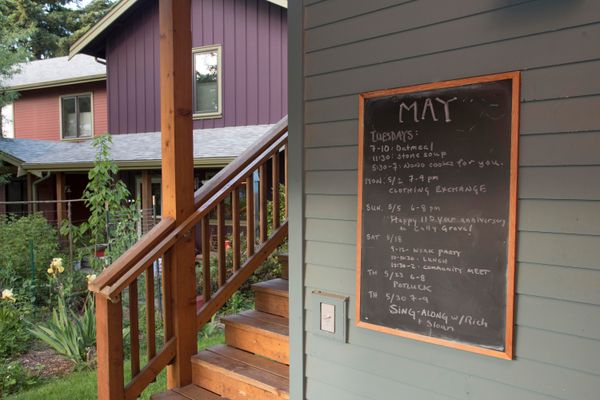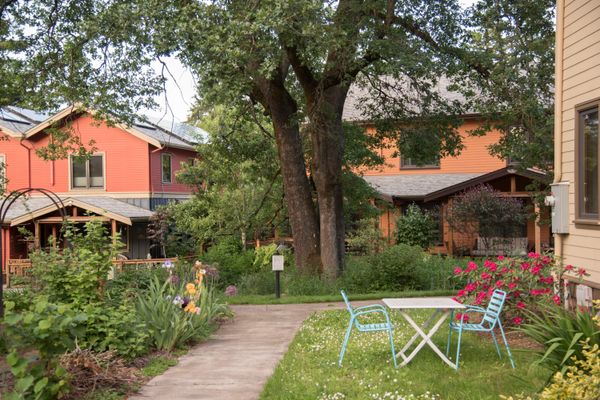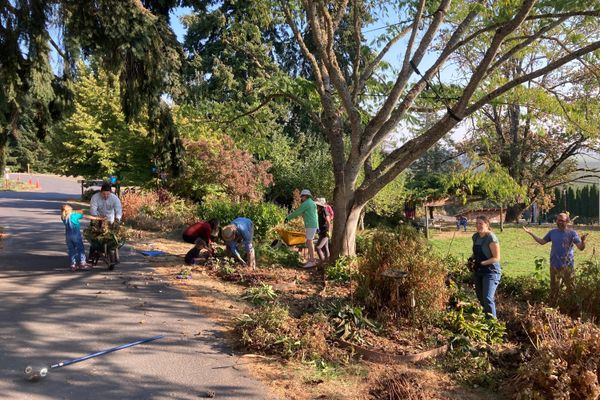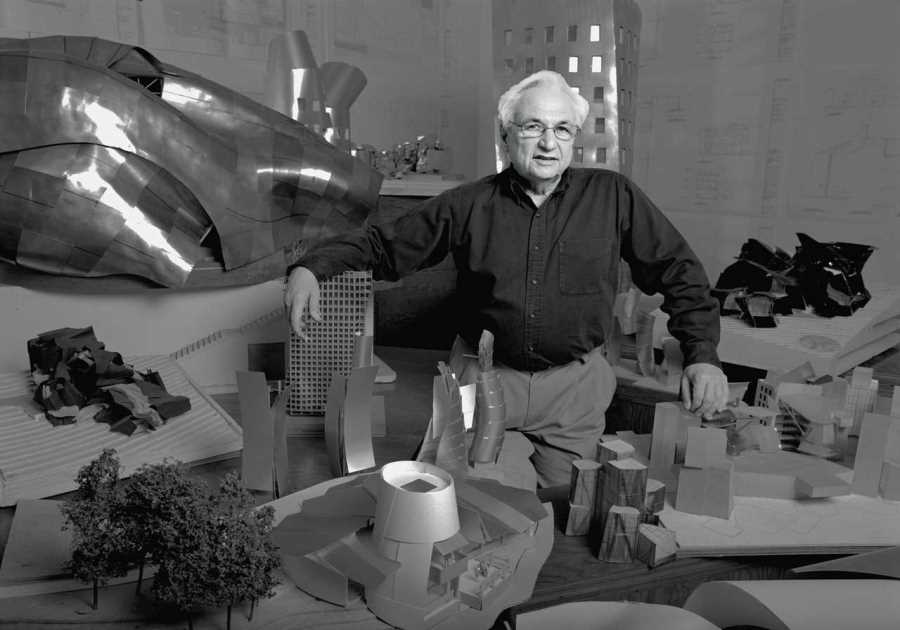When a wildfire and freak ice storm made me face my eco-anxiety head on, I set out to see if community-forward co-living might soothe it.
I remember the moment I couldn’t deny my climate anxiety any longer. It was September 2017, and an ethereal, orange-red light was shining through our window, landing at the feet of my then-six-month-old baby. The beauty of the scene was eclipsed by the source of the light—a sun obscured by wildfire smoke blown in from the Eagle Creek Fire that was raging in the Columbia River Gorge to the east of where I lived in Portland, Oregon. The scene of my baby amidst a seeming apocalypse highlighted a dual crisis: raising a child in a dying world.
The feeling was overwhelming, and it resulted in me beginning to focus my writing toward the intersection of climate change and disaster preparedness. My anxiety prompted me to prepare by stocking up on food and water and creating go-bags. Preparing alone felt futile. But in early 2024, during a freak ice storm that blanketed the city in a sheet of ice for several days, when I could barely walk across the street to deliver bread to my elderly neighbor, I remembered a conversation I’d had with a colleague and friend Noelle Studer-Spevak a couple years before. She told me about living in a cohousing community. Initially I’d dismissed the concept; it made me think of living with roommates. But after that winter storm, I wondered: would these communities be more prepared for an uncertain future because of a shared agreement to support one another?

Cully Grove is a 16-unit community in Northeast Portland, Oregon. Its residents commit to "respect and care for other people and the earth" as a shared value of living there.
Photo by Brian Foulkes
We have the Danes to thank for our modern understanding of cohousing, which they call bofællesskaber, or co-living communities. They are abundant in Denmark, where, in the 1970s and 1980s, socialized housing developments emerged from a culture interested in collectivism and experimentation. Cohousing communities are intentional, self-governing groups invested in cooperative living. Their private residences are in close proximity to one another with ample shared space—large courtyards, a "common house," and various lounge areas—where day-to-day social interaction occurs. Resources are shared and group decisions are made. Many people who join are drawn to the smaller environmental footprint that comes with shared resources, but most come for the community.
Architects Charles Durrett and Kathryn McCamant brought the cohousing concept to the U.S. in the late 1980s. While the early cohousing phenomenon in Denmark was government-supported, in the U.S., the existence of such communities emerged from intrepid groups of individuals with enough money to develop and build an entire condo development, and the patience to work through a labyrinth of logistics and bureaucracy to get the right permits and adhere to zoning laws. Cohousing enthusiasts are a determined bunch, and nearly 170 communities have emerged here with around 140 currently in development, according to the Cohousing Association of the United States. Most are built to be multigenerational, but many seniors looking for an alternative to retirement living have developed them as well.
Having only heard about cohousing, I wanted to find out what features might make these communities more resilient to climate change. Luckily, there are ample opportunities in Portland, where there are over a dozen to choose from. I took on a quest to visit four: First, the sister communities Cully Grove (where Noelle lives) and Cully Green, for an idea of bucolic city-living. (The 16 and 23 households, respectively, sit on around two-acres of land each in the Cully neighborhood in Northeast Portland.) Then, I went to the more urbanized condo-style communities of Daybreak Cohousing, which consists of 30 households in North Portland, and to the senior cohousing community, PDX Commons, which holds 27 units on a busy Southeast Portland thoroughfare. Finally, for a view into rural cohousing, I visited Green Grove, a community of nine detached single-family homes, sitting on a 10-acre plot 25 miles outside Portland in Forest Grove. I hoped my journey would help with some answers.

Cully Grove sits across from Cully Green (seen up top), which has 23 homes. Both have shared outdoor and indoor spaces.
Photo by Brian Foulkes
Collective Action at Cully Grove and Cully Green
The grounds at Cully Grove teemed with people—they were digging up weeds, tending the garden, and performing general maintenance. Noelle Studer-Spevak, my host and cofounder of the Cully communities, noted that a work party—a monthly gathering where residents get together to maintain the grounds—was the perfect time to see everything in action. While showing me around the lush gardens of the modest townhomes, she fell into spontaneous conversations with some of the many of the residents who stayed to chat and eat after-work lentil soup on the lawn around the townhomes. There, I asked some of them about emergency preparedness.
"I did a survey from the city yesterday, and it asked ‘do you know at least one neighbor that would help you in an emergency?’ and I chuckled," says Cully Green resident Kiel Johnson. "Just one?" chimes in Christa McDermott, another resident, laughing. Johnson’s reaction shows how unique their situation is; according to a 2019 Pew study, 57 percent of Americans say they know only some of their neighbors, and only 58 percent of those people actually interact with these neighbors socially. The Cully residents, however, are in contact with the 93 people of both developments, often daily, by way of email and a Slack set up for residents where they handle everything from last-minute dinner ingredient requests to offers of free items to summer camp carpool planning. On top of that, residents spark up spontaneous conversations with one another by the recycling bins or around the grounds.
These social ties aren’t just nice—they’re important. "The number one thing I always say to community groups is, ‘Do you want to survive in a disaster? Well, then you better know your neighbor,’" Lori Peek, director of the Natural Hazards Center at the University of Colorado Boulder told me for a story I wrote a few years back on earthquake preparedness. As we talk, McDermott expands on the value of long-term readiness: "I think we can adapt because there are other experts around."
"What works in this community is that we do the physical really well," resident Abe Cohen tells me. "We take care of the grounds, we have good organizers, we have willing participants." He uses the work party as an example, but also the various committees people are on to keep the buildings and grounds maintained and functioning, doing tasks such as gardening, weeding, or finding and hiring contractors to take care of the things that the community can’t do, like fixing a problem with the solar panels or generators for the shared spaces. Cohen probably wasn’t thinking in terms of emergency prep, but I pictured Cully Grove in that 2024 ice storm. Instead of a monthly work party, I could easily see the same people clearing ice, checking on neighbors, and making pots of lentil soup. "What resilience often comes down to is not wealth or insurance, but the network that you formed, how much information and collective action you can accomplish," says Daniel Aldrich, director of security and resilience studies at Northeastern University.
Daybreak Cohousing was founded in 2009 in the Overlook neighborhood of Portland. It features 30 units and was designed to have "sustainability features in all units," with details such as stormwater management and energy-efficient windows.
Courtesy Daybreak CohousingCollaboration at Daybreak Cohousing
My host, membership committee member Theo Spanos, introduces most residents at Daybreak Cohousing by also noting their committee. The teams of residents, it seems, run this place.
Dayna Sinipoli tells me she joined the emergency preparedness team two-and-a-half years ago when she moved into the vibrant, orange-and-yellow condo surrounding a courtyard shaded by a 50-year-old silver maple tree. "I’ve been a Navy Medic and I worked in hospitals my whole life, so being in [emergency] situations was really kind of normal for me," she says. "We started having happy hours where we would talk about emergency prep and show some things what people could be doing," like creating go-bags and storing water. Now, Daybreak has robust emergency stores, an annual preparedness book club, and regular updates when any event is happening.
Daybreak’s architect and designer, Grace Kim, sees this foresight as essential to cohousing. "I would actually say that the architecture isn’t important—it’s the intention to collaborate and live in a very interdependent way," she says. But the architecture can facilitate this. "I try to create opportunities for informal connection—whether it’s creating a little spot or a node at the mailboxes, or trying to create a little spot where it's easy for people to sit and and be part of the ebb and flow of the traffic across the site or in the building, making sure that from your kitchen window you can see the activity of the community." But without the commitment of the residents to actively engage in the community, those "nodes" Kim designs are merely a place to nod hello and move on.
The group at the Cully communities pointed out the development right next door to them. It has many of the architectural markers of cohousing, such as some shared spaces and joint storage areas, but residents don’t come in with the same expectations and, as such, from their observation, don’t appear to have deep connections with one another.
Community Decision-Making at PDX Commons
When my tour guide, Marjorie McRae, takes me through PDX Commons, she shows me the joint crafting and workout space. The craft supplies are tucked into a collapsible wardrobe, while the rest of the space is filled with a weight machine and barbells.
"The approval to get this equipment just finalized," McRae tells me. "It takes a long time to come to a decision." Like most cohousing communities, PDX Commons uses consensus decision-making, an inclusive approach where residents work together on proposals that go through various drafts and discussions before a final decision is made. She believes that’s part of their resilience to change or weathering emergencies; the process builds trust that, in turn, helps build an emotional support system that is essential to resilience. "We have trust because we have procedures," she says.
But it’s an adjustment to work that way for many. "Some of us ran our own businesses and were used to calling the shots on our own," says cofounder Jim Swenson. "That was a real barrier to get over is trusting the wisdom of the group and letting people speak and listening to people," he notes, specifically of the years-long development process to design and build PDX Commons. They used the Universal Design model where the spaces can be accessible to everyone regardless of age, ability, or size allowing residents to age in place while also using the highest sustainability standards for insulation, lighting systems, and solar power generation. For example, the building’s second-floor Great Room, which is accessible by stairs or an elevator, has a large, open plan with an industrial kitchen featuring counter heights amenable to folks in wheelchairs or standing. They also have backup generators for common spaces in case of power outages and rooftop gardens to grow food.
McRae sums it up concisely: "We all pay attention to how to work together."

The Green Grove Cohousing Community is located outside of Portland in Forest Grove. It features solar panels, rainwater irrigation, and residents agree to a set of sustainability practices, though they note that they "consciously avoid zealotry" in their pledge to them.
Courtesy Green Grove Cohousing
See the full story on Dwell.com: Could Cohousing Save Your Life in a Climate Disaster?
Related stories:
- They Built Their Home Around a Grove of Ancient Stumps in the Washington Woods
- Named "House 2.0," This Isn’t Your Run-of-the-Mill Eco-Home
- On a Once-Vacant Corner Lot in Jersey City, a Sustainable Prefab Rises for $252K
Read More
By: Elizabeth Doerr
Title: Could Cohousing Save Your Life in a Climate Disaster?
Sourced From: www.dwell.com/article/could-cohousing-save-your-life-in-a-climate-disaster-35822dd4-8b18ed01-c51e77dc-8b7a92e0
Published Date: Thu, 31 Jul 2025 12:12:32 GMT
.png)





